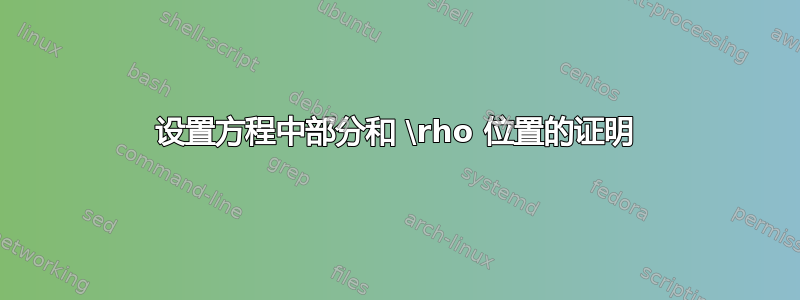
答案1
正如评论中提到的那样,与非下降字符相比,诸如p、\rho和 之类的字母y(在数学模式或普通模式下)总是看起来很奇怪。 如果您确实希望对齐所有字符,则有两种方法可以做到这一点:
第一个是重新定义\rho,以便垂直移动3pt:
\documentclass[]{article}
\usepackage{amsmath}
% Copied from TeX.SE but I didn't save where I got it explicitly :(
\let\plainRho\rho
\renewcommand{\rho}[1][0pt]{%
\mathrel{\raisebox{3pt}{$\plainRho$}}%
}
\begin{document}
\noindent Using the plain \verb|\plainRho| vs the modified version \verb|\rho|:
\begin{align*}
\frac{{\partial{\plainRho}_{{K}}}}{\partial t} & ~ &
\frac{{\partial{\rho}_{{K}}}}{\partial t}\\
\end{align*}
\end{document}
第二种选择是将输入全部移位,而不是逐个字母移位。注意使用\down和 的下标\furtherDown。
\documentclass[]{article}
\usepackage{amsmath}
\newcommand\up[1]{\mbox{\raisebox{2.5pt}{\ensuremath{#1}}}} % Raise the input.
\newcommand\down[1]{\mbox{\raisebox{2.5pt}{{\tiny\ensuremath{#1}}}}} % shift input down but within reason.
\newcommand\furtherDown[1]{\mbox{\raisebox{-1pt}{{\tiny\ensuremath{#1}}}}} % shift subscript further
\begin{document}
\noindent Using original vs \verb|\up{\rho}|
\begin{align*}
\text{Original: }\frac{\partial\rho_{\down{K}}}{\partial t} &
\text{~~~Using $\backslash$up\{$\backslash$rho\}:~~~}\frac{\partial\up{\rho}_{\down{K}}}{\partial t}
\end{align*}
\noindent Using \verb|\up and \down| vs \verb|\up and \futherDown|
\begin{align*}
\frac{\partial\up{\rho}_{\down{K}}}{\partial t} &
\frac{\partial\up{\rho}_{\furtherDown{K}}}{\partial t}\\
\end{align*}
\noindent Shifting $y$ instead of $\rho$:
\begin{align*}
\frac{\partial y_{\down{K}}}{\partial t} &
\frac{\partial\up{y}_{\down{K}}}{\partial t}\\
\end{align*}
\end{document}







